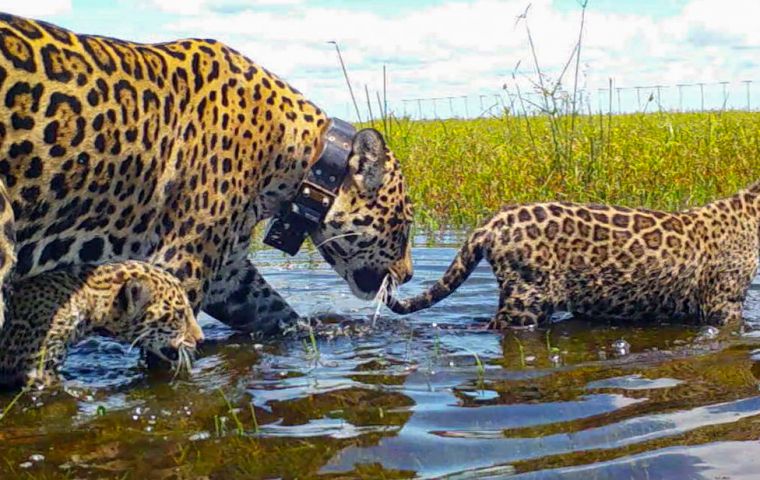MercoPress. South Atlantic News Agency
Re-wilding Project: the Jaguar has returned to South America wetlands after 70 years
 Mariua, an adult jaguar who was rescued as an orphan cub in Brazil, and her two captive-born cubs were released into Gran Iberá Park in January 2021
Mariua, an adult jaguar who was rescued as an orphan cub in Brazil, and her two captive-born cubs were released into Gran Iberá Park in January 2021 The largest predator in South America, the jaguar, has returned to the Iberá wetlands in Argentina 70 years after the species was driven to local extinction through hunting and habitat loss. Currently, only about 200 jaguars remain in Argentina.
Mariua, an adult jaguar who was rescued as an orphan cub in Brazil, and her two captive-born cubs were released into Gran Iberá Park in January 2021. They are the first of nine jaguars slated to repopulate the species in the, a 687,966 hectare protected area, which offers an abundance of wild prey for the big cats.
The release marks the first reintroduction of jaguars in a place where they have gone extinct. It is part of an effort known as “re-wilding” – restoring the missing species, biodiversity, and natural processes to areas affected by human activity.
“Carefully re-introducing predators such as jaguars can help restore ecosystems. Without these species, biodiversity suffers and the services that nature provides can break down – from disease mitigation and soil protection to water system regulation,” says Doreen Robinson, Chief of Wildlife at the United Nations Environment Programme (UNEP).
UNEP and partners such as the Global Reswilding Alliance, an official partner of the United Nations Decade on Ecosystem Restoration 2021/2030, support global re-wilding efforts to help stem catastrophic biodiversity loss. UNEP is also working on jaguar conservation through its Wild Life campaign, which raises awareness of the illegal trade in wildlife and works with countries and local communities to protect endangered species.
The third-largest feline on the planet, the jaguar has lost over half its historical range, leaving some populations geographically isolated and with dangerously reduced gene pools. It is an important cultural icon too: the Guarani people of northeastern Argentina value the jaguar as a symbol of strength and an essential element of the region’s identity.
In 2018, at a critical and uncertain time for the future of the jaguar, four leading international organizations – the United Nations Development Program, World Wildlife Fund, Wildlife Conservation Society, and Panthera – and 14 jaguar range states, including Argentina, launched the 2030 Jaguar Conservation Roadmap for the Americas, presented at the Conference of Parties (COP) 14 of the Convention on Biological Diversity. The plan enables trans-boundary, collaborative work at the continental scale.
Saving the species was deemed a priority by the International Union for Conservation of Nature at the World Conservation Congress in September 2020. Another important recent development is the inclusion of the jaguar in the appendices of the Convention on the Conservation of Migratory Species of Wild Animals, also known as the Bonn Convention.
Bringing back top predators such as the jaguar and the giant river otter, and seed bearers like peccaries and macaws is helping the Iberá wetlands recover from hunting and decades of cattle grazing and monoculture plantations, according to Sebastian Di Martino, Director of Conservation at Re-wilding Argentina, a strategic partner of Tompkins Conservation, and the organization leading the project.




Top Comments
Disclaimer & comment rulesCommenting for this story is now closed.
If you have a Facebook account, become a fan and comment on our Facebook Page!